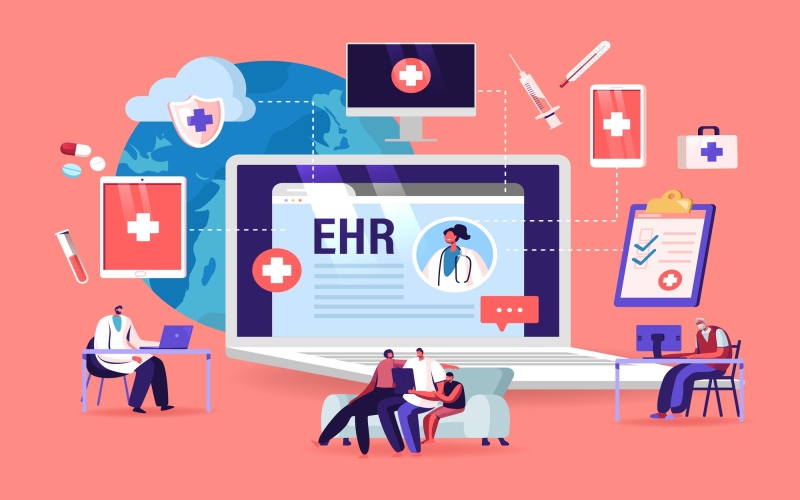In the rapidly evolving landscape of healthcare, technology continues to revolutionize the way patient care is delivered and managed. One of the most notable advancements in healthcare involves integration techniques, particularly the integration of Electronic Health Records (EHR) and Electronic Medical Records (EMR) with healthcare systems
In this blog post, we will provide a concise overview of Electronic Health Records (EHR) and Electronic Medical Records (EMR) and the transformative impact of EHR-EMR integration on healthcare. By delving into the benefits of EHR/EMR integration, our aim is to shed light on how it is reshaping the healthcare industry and empowering both healthcare providers and patients alike.
What is an Electronic Medical Record (EMR)?
Electronic Medical Record (EMR) is a digital version of a patient’s paper chart in a healthcare provider’s office. It contains the medical and treatment history of patients in one practice and is typically used for diagnosis and treatment within that specific practice.
EMR integration involves the seamless exchange of data between different electronic medical record (EMR) systems or between EMR systems and other healthcare IT systems. This process typically utilizes standardized protocols and interfaces to ensure compatibility and interoperability.
Through integration, EMR systems can share patient information, such as medical history, diagnoses, medications, and test results among healthcare providers and systems involved in a patient’s care. This facilitates better communication, coordination, and decision-making, ultimately enhancing the quality and efficiency of healthcare delivery.
What is an Electronic Health Record (EHR)?
On the other hand, an Electronic Health Record (EHR) is a more comprehensive digital record of a patient’s health information. It goes beyond the data collected in the provider’s office and includes a broader view of a patient’s care across multiple healthcare providers, including specialists, hospitals, pharmacies, and laboratories. EHRs are designed to be shared across different healthcare settings, providing a more complete picture of a patient’s health history.
How EHR Integration Works?
Electronic Health Record (EHR) integration is the process of connecting disparate healthcare systems to facilitate seamless exchange of patient information. Through interoperability standards, such as HL7 (Health Level Seven) and FHIR (Fast Healthcare Interoperability Resources), EHR integration enables healthcare providers to access comprehensive patient records from different sources in a unified interface.
This integration typically involves mapping data elements, establishing secure communication channels, and ensuring compliance with regulatory requirements such as HIPAA. By consolidating patient data from various systems, EHR integration enhances care coordination, improves efficiency, and fosters better clinical decision-making.
How Does EHR Integration Enhance Healthcare?
integrating Electronic Health Records (EHR) into healthcare systems offers numerous benefits and enhancements to healthcare delivery. Here are some key ways EHR integration improves healthcare:
- Efficiency: Integrating EHR systems allows healthcare providers to access patient records seamlessly, reducing time spent searching for information and eliminating duplication of data entry. This efficiency translates to faster patient care and fewer administrative errors.
- Interoperability: EHR Integration facilitates communication between different healthcare systems and providers. This interoperability in healthcare enables the exchange of patient data across various healthcare settings, ensuring continuity of care and promoting collaboration among healthcare professionals.
- Improved Patient Care: EHR integration provides healthcare providers with comprehensive and up-to-date patient information, including medical history, medications, allergies, and test results. Having access to this information at the point of care enables clinicians to make more informed decisions, leading to better patient outcomes.
- Enhanced Decision Making: Integration of EHR systems enables healthcare providers to leverage advanced analytics and decision support tools. By analyzing large datasets and utilizing clinical decision support systems, clinicians can identify trends, predict potential health issues, and tailor treatment plans to individual patients, ultimately improving clinical decision-making.
- Patient Engagement and Empowerment: EHR integration enables patients to access their own health information securely through patient portals or mobile apps. Empowering patients with access to their medical records, test results, and treatment plans promotes active participation in their healthcare journey, leading to better communication between patients and providers and improved health outcomes.
How Does EMR Integration Enhance Healthcare?
Here are some key ways EMR integration improves healthcare:
- Efficient Information Retrieval: EMR integration allows healthcare providers to access patient records quickly, leading to faster diagnosis and treatment decisions.
- Reduced Duplication of Tests: Integrated EMR systems enable healthcare providers to view comprehensive patient histories, reducing the need for duplicate tests and procedures.
- Improved Documentation and Compliance: EMR integration helps standardize documentation practices, ensuring that healthcare providers adhere to regulatory requirements and maintain accurate records.
- Enhanced Communication: Integration facilitates communication among healthcare team members, enabling them to share updates, collaborate on patient care plans, and provide timely interventions.
- Cost Savings: Integrated EMR systems can lead to cost savings by reducing administrative burdens, minimizing inefficiencies, and preventing unnecessary healthcare utilization.
Summary:
EHR/EMR integration enhances healthcare by improving care coordination, patient safety, workflow efficiency, communication, data analytics, and patient engagement, ultimately leading to better outcomes and experiences for both patients and providers.





